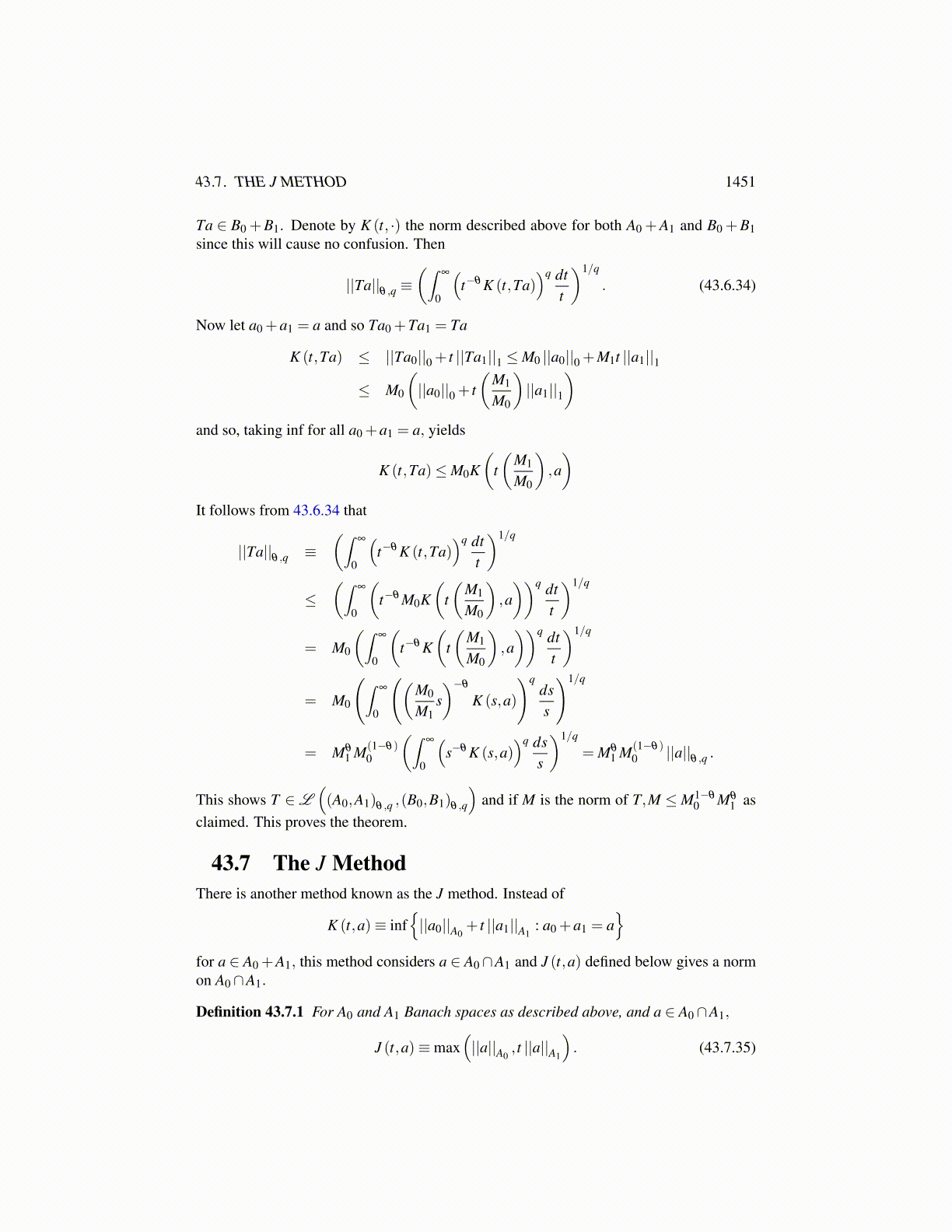
43.6. THE K METHOD 1451
and T is a linear map from A0 +A1 to B0 +B1 where the Ai and Bi are Banach spaces withthe properties described above, then it follows
T ∈L((A0,A1)θ ,q ,(B0,B1)θ ,q
)(43.6.30)
and if M is its norm, and M0 and M1 are the norms of T as a map in L (A0,B0) andL (A1,B1) respectively, then
M ≤M1−θ
0 Mθ1 . (43.6.31)
Proof: Suppose first a ∈ A0∩A1. Then
||a||qθ ,q ≡
∫ r
0
(t−θ K (t,a)
)q dtt+∫
∞
r
(t−θ K (t,a)
)q dtt
(43.6.32)
≤∫ r
0
(t−θ ||a||1 t
)q dtt+∫
∞
r
(t−θ ||a||0
)q dtt
= ||a||q1∫ r
0tq(1−θ)−1dt + ||a||q0
∫∞
rt−1−θqdt
= ||a||q1rq−qθ
q−qθ+ ||a||q0
r−θq
θq< ∞ (43.6.33)
Which shows the first inclusion of 43.6.26. The above holds for all r > 0 and in particularfor the value of r which minimizes the expression on the right in 43.6.33, r = ||a||0 / ||a||1.Therefore, doing some calculus,
||a||qθ ,q ≤
1θq(1+θ)
||a||q(1−θ)0 ||a||qθ
1
which shows 43.6.28. This also verifies that the first inclusion map is continuous in 43.6.26because if an→ 0 in A0∩A1, then an→ 0 in A0 and in A1 and so the above shows an→ 0in (A0,A1)θ ,q.
Now consider the second inclusion in 43.6.26. This is obvious since (A0,A1)θ ,q is givento be a subset of A0 +A1 defined by(∫
∞
0
(t−θ K (t,a)
)q dtt
)1/q
< ∞
It remains to verify the inclusion map is continuous. Suppose an→ 0 in (A0,A1)θ ,q. Sincean→ 0 in (A0,A1)θ ,q , it follows the function, t→ t−θ K (t,an) converges to zero in Lq (0,∞)with respect to the measure, dt/t. Therefore, taking another subsequence, still denoted asan, you can assume this function converges to 0 a.e. Pick such a t where this convergencetakes place. Then K (t,an)→ 0 as n→ ∞ and so an → 0 in A0 + A1. (Recall all thesenorms K (t, ·) are equivalent.) This shows that if an→ 0 in (A0,A1)θ ,q , then there exists asubsequence
{ank
}such that ank → 0 in A0 +A1. It follows that if an→ 0 in (A0,A1)θ ,q ,
then an→ 0 in A0 +A1. This proves the continuity of the embedding.What about 43.6.27? Suppose {an} is a Cauchy sequence in (A0,A1)θ ,q. Then from
what was just shown this is a Cauchy sequence in A0 +A1 and so there exists a ∈ A0 +A1